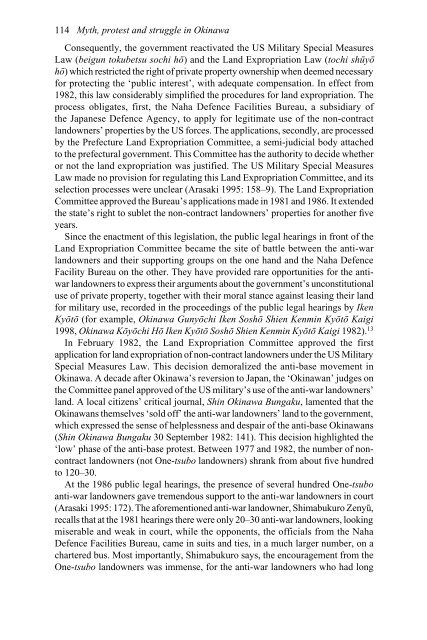Myth, Protest and Struggle in Okinawa
Myth, Protest and Struggle in Okinawa
Myth, Protest and Struggle in Okinawa
You also want an ePaper? Increase the reach of your titles
YUMPU automatically turns print PDFs into web optimized ePapers that Google loves.
114 <strong>Myth</strong>, protest <strong>and</strong> struggle <strong>in</strong> Ok<strong>in</strong>awa<br />
Consequently, the government reactivated the US Military Special Measures<br />
Law (beigun tokubetsu sochi hō) <strong>and</strong> the L<strong>and</strong> Expropriation Law (tochi shūyō<br />
hō) which restricted the right of private property ownership when deemed necessary<br />
for protect<strong>in</strong>g the ‘public <strong>in</strong>terest’, with adequate compensation. In effect from<br />
1982, this law considerably simplified the procedures for l<strong>and</strong> expropriation. The<br />
process obligates, first, the Naha Defence Facilities Bureau, a subsidiary of<br />
the Japanese Defence Agency, to apply for legitimate use of the non-contract<br />
l<strong>and</strong>owners’ properties by the US forces. The applications, secondly, are processed<br />
by the Prefecture L<strong>and</strong> Expropriation Committee, a semi-judicial body attached<br />
to the prefectural government. This Committee has the authority to decide whether<br />
or not the l<strong>and</strong> expropriation was justified. The US Military Special Measures<br />
Law made no provision for regulat<strong>in</strong>g this L<strong>and</strong> Expropriation Committee, <strong>and</strong> its<br />
selection processes were unclear (Arasaki 1995: 158–9). The L<strong>and</strong> Expropriation<br />
Committee approved the Bureau’s applications made <strong>in</strong> 1981 <strong>and</strong> 1986. It extended<br />
the state’s right to sublet the non-contract l<strong>and</strong>owners’ properties for another five<br />
years.<br />
S<strong>in</strong>ce the enactment of this legislation, the public legal hear<strong>in</strong>gs <strong>in</strong> front of the<br />
L<strong>and</strong> Expropriation Committee became the site of battle between the anti-war<br />
l<strong>and</strong>owners <strong>and</strong> their support<strong>in</strong>g groups on the one h<strong>and</strong> <strong>and</strong> the Naha Defence<br />
Facility Bureau on the other. They have provided rare opportunities for the antiwar<br />
l<strong>and</strong>owners to express their arguments about the government’s unconstitutional<br />
use of private property, together with their moral stance aga<strong>in</strong>st leas<strong>in</strong>g their l<strong>and</strong><br />
for military use, recorded <strong>in</strong> the proceed<strong>in</strong>gs of the public legal hear<strong>in</strong>gs by Iken<br />
Kyōtō (for example, Ok<strong>in</strong>awa Gunyōchi Iken Soshō Shien Kenm<strong>in</strong> Kyōtō Kaigi<br />
1998, Ok<strong>in</strong>awa Kōyōchi Hō Iken KyōtōSoshō Shien Kenm<strong>in</strong> KyōtōKaigi 1982). 13<br />
In February 1982, the L<strong>and</strong> Expropriation Committee approved the first<br />
application for l<strong>and</strong> expropriation of non-contract l<strong>and</strong>owners under the US Military<br />
Special Measures Law. This decision demoralized the anti-base movement <strong>in</strong><br />
Ok<strong>in</strong>awa. A decade after Ok<strong>in</strong>awa’s reversion to Japan, the ‘Ok<strong>in</strong>awan’ judges on<br />
the Committee panel approved of the US military’s use of the anti-war l<strong>and</strong>owners’<br />
l<strong>and</strong>. A local citizens’ critical journal, Sh<strong>in</strong> Ok<strong>in</strong>awa Bungaku, lamented that the<br />
Ok<strong>in</strong>awans themselves ‘sold off’ the anti-war l<strong>and</strong>owners’ l<strong>and</strong> to the government,<br />
which expressed the sense of helplessness <strong>and</strong> despair of the anti-base Ok<strong>in</strong>awans<br />
(Sh<strong>in</strong> Ok<strong>in</strong>awa Bungaku 30 September 1982: 141). This decision highlighted the<br />
‘low’ phase of the anti-base protest. Between 1977 <strong>and</strong> 1982, the number of noncontract<br />
l<strong>and</strong>owners (not One-tsubo l<strong>and</strong>owners) shrank from about five hundred<br />
to 120–30.<br />
At the 1986 public legal hear<strong>in</strong>gs, the presence of several hundred One-tsubo<br />
anti-war l<strong>and</strong>owners gave tremendous support to the anti-war l<strong>and</strong>owners <strong>in</strong> court<br />
(Arasaki 1995: 172). The aforementioned anti-war l<strong>and</strong>owner, Shimabukuro Zenyū,<br />
recalls that at the 1981 hear<strong>in</strong>gs there were only 20–30 anti-war l<strong>and</strong>owners, look<strong>in</strong>g<br />
miserable <strong>and</strong> weak <strong>in</strong> court, while the opponents, the officials from the Naha<br />
Defence Facilities Bureau, came <strong>in</strong> suits <strong>and</strong> ties, <strong>in</strong> a much larger number, on a<br />
chartered bus. Most importantly, Shimabukuro says, the encouragement from the<br />
One-tsubo l<strong>and</strong>owners was immense, for the anti-war l<strong>and</strong>owners who had long
















